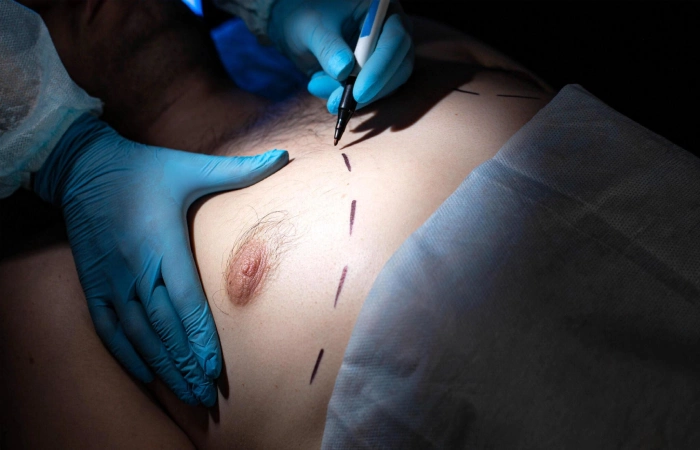The swelling and excess development of male breast gland tissue (gynecomastia) is often caused by an estrogen and testosterone imbalance in men. And it can affect one or both gland tissues, sometimes unevenly.
The condition causes abnormally enlarged chest tissue, and the sagging “man boobs” tend to stretch the areola (the dark skin surrounding the nipple).
Table of Contents
Signs of Gynecomastia
Overdeveloped breast tissue in men can occur at any age. And is a cause of hormonal changes, obesity, heredity, or using certain drugs. The condition can cause low self-esteem and emotional discomfort, with some men avoiding certain physical activities like workouts or intimacy.
Signs of gynecomastia include:
- Excess localized fat
- Excess breast skin
- Extra breast gland tissue development
- Presence in one or both breast tissues
- Pain and discomfort from the enlarged breast tissue
Is It Safe to Go for a Male Breast Reduction Surgery?
Gynecomastia surgery (reduction mammaplasty) corrects overdeveloped or enlarged breast tissue in men. This surgical procedure is safe when performed by an experienced surgeon. And it resizes, flattens, and enhances the patient’s natural chest contours; it also improves the position and size of the areola.
Are You a Good Candidate for Male Reduction Mammaplasty?
The procedure to control enlarged breast tissue in men is suitable for most patients unless they suffer from certain medical conditions or are using blood-thinning medications. This surgical procedure improves the patient’s quality of life and contributes to higher self-esteem, as they feel more comfortable in clothing.
The cosmetic procedure involves:
Liposuction
Using a thin metal cannula, the plastic surgeon performs suction-assisted liposuction to remove the excess fatty tissue. Liposuction is ideal for breasts with moderate excess fatty tissue and without excess skin laxity. It results in tiny but discrete scars where the surgeon performed the cannula insertion.
Excision
The surgeon performs direct excision of the excess tissue and skin. And re-contours the chest tissue, repositioning the nipple-areola area. This surgical technique is ideal for patients with moderate to severe conditions and excess skin laxity. The incision scar size may vary, depending on the extent of the procedure.
Combination
This reduction mammaplasty procedure involves a combination of liposuction and excision to achieve the desired outcomes.
The technique used will help to determine the gynecomastia surgery cost in Newport Beach, CA.
How Common Is Gynecomastia?
Gynecomastia affects more than half of males around the world. And about 20,000 patients undergo this surgical procedure each year. It can develop during the hormonal changes that happen during adolescent development or as one gets older.
What Should You Expect After Gynecomastia Surgery?
During the procedure, the surgeon places thin tubes under the skin to collect and drain fluid and blood from the healing wound to a receptacle or bulb. And then wraps the incision area with a bandage and supportive garment and prescribes drugs that reduce swelling and prevent infection. As the healing continues, the surgeon removes these tubes when they are no longer necessary.
After the procedure and during the healing process, you will need close support from friends or relatives who will drive you home and help you take care of the incisions.
What Are the Risks of Gynecomastia Surgery?
Like other invasive surgical procedures, a reduction mammaplasty may have complications that include:
- Excessive bleeding or blood clots
- Different-sized or shaped breasts
- Bruises and scarring
- Infection
- Decreased sensitivity or numbness in the breast area
- Pain or discomfort during the healing process
The surgeon discusses these risks and their remedies with the patient before proceeding. Some of these remedies include a corrective surgery that helps the patient achieve the desired results.
Gynecomastia Surgery Q&A
Q: What is the ideal age for gynecomastia surgery?
A: If you are at least 18 years, you can undergo gynecomastia surgery.
Q: Why is it good to talk to the provider about the desired outcomes?
A: Talking to your provider about your desired outcomes helps to set and achieve a realistic goal and helps to learn more about the benefits and risks.
Q: How painful is the healing process after gynecomastia surgery?
A: The pain is minimal to moderate and gradually reduces as you take the pain prescription medications.
Q: How long do I need drains after the surgical procedure?
A: Fluid drains usually stay in place for one to two weeks, after which a surgeon removes them in a clinic.
Q: Why should a patient avoid physical activity after surgery?
A: Participating in physical activity causes tension or friction to the healing incisions.
Q: How long should I wear a compression garment during the healing process?
A: A patient should wear a compression vest for about six weeks to improve the contour and control swelling.
Q: After how long is it safe to resume physical activity?
A: For a desk job, it’s safe to resume work after five to seven days, and for more engaging activities like light exercises, after two weeks.
Q: When is it necessary to see the surgeon after the procedure?
A: Consult your surgeon as soon as you notice bleeding or pus, if the incision opens, or if you experience severe pain, swelling, or redness near the incision.

